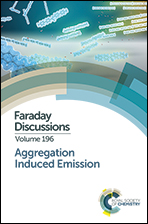Development of solid-state emissive o-carboranes and theoretical investigation of the mechanism of the aggregation-induced emission behaviors of organoboron “element-blocks”
Abstract
This paper presents the aggregation-induced emission (AIE) properties of o-carborane derivatives and proposes a potential strategy for constructing AIE-active organoboron complexes via the enhancement of freedom of intramolecular mobility. Initially, the optical properties of o-carborane derivatives with or without the fused ring structure at the C–C bond in o-carborane in which elongation should be induced by photo-excitation according to theoretical calculations were compared. Accordingly, it was shown that large mobility at the C–C bond in o-carborane should be responsible for the annihilation of emission in solution, leading to the AIE property. From this result, it was presumed that by enhancing the freedom of intramolecular mobility in conventional luminescent organoboron complexes, the deactivation of the excited state in solution and emission recovery in the aggregate can be induced. Based on this idea, we have performed several studies and introduce two representative results. Firstly, the decrease in luminescent properties of boron dipyrromethene (BODIPY) in solution by introducing a movable functional group is explained. Next, the AIE behaviors of boron ketoiminates and the potential mechanism concerning conformational changes for the deactivation of the excited state in the solution state are illustrated. It is proposed that enhancement of the freedom of mobility in the excited state of luminescent organoboron complexes could be a potential strategy for realizing AIE behaviors.
- This article is part of the themed collection: Aggregation Induced Emission

 Please wait while we load your content...
Please wait while we load your content...